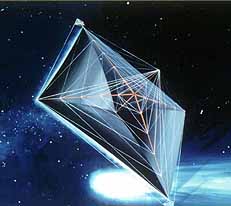|
-------------------------- ------------------- Solar Shocks |
Gradual acceleration by low thrustThe biggest hurdle for spaceflight is the first step: getting off the ground into some stable orbit above the dense atmosphere. Be it by rocket, gun or nuclear power, that step is the hardest, requiring a concentrated expenditure of energy and propellant mass. The initial orbit is generally the lowest one possible, the one requiring the smallest thrust. But the final goal could be a higher orbit, the Moon, a planet or comet, or even some target outside the solar system. The thrust needed to reach the final orbit from the initial one does not have to be delivered in a single, powerful blast: gradual acceleration will also work, which opens the door to alternative, more efficient methods of propulsion. The Solar Sail
One such method is the use of a solar sail, relying on the pressure of sunlight. That pressure (together with the pressure of the solar wind) makes comet tails point away from the Sun--not only when the comet approaches the Sun and its tail trails behind it, but also after it has passed the Sun and moves away, when the tail stretches ahead of the comet. The solar sail uses this pressure in much the same way as a sailing ship uses the wind. It would consist of a large sheet of reflective material, such as the mylar film which is used to keep spacecraft from overheating, and a framework of girders to keep it extended and to transmit its pressure to the spacecraft. Various designs have been proposed. |
